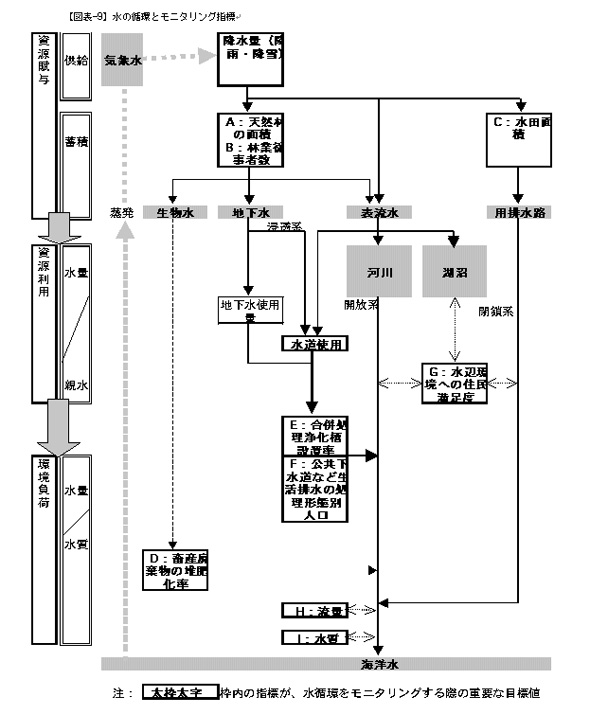3: What is the plan 3-2-2
3-2-2. In order to promote conservation and cultivation of the water cycle, the basic idea is to preserve water circulation.
(1) Think water conservation and cultivation in the water cycle
Water circulation is not the only visible river environment. The meteorological phenomenon that starts from precipitation and evaporates is also a big cycle of water circulation. In addition, various ecosystems formed by river and its various animals and plants and riverbed soil constitute an important part of river water circulation. Salts and the like that runs up the river play an important role (material circulation) of returning nutrients from the ocean to the mountains, and wild birds living in the forest also spread feces and seeds around them, spread forests, It plays a big role to increase.
The circulation of water in the natural environment is based on an exquisite balance that continuously guarantees various blessings on the earth.
The circulation of water in the natural environment is based on an exquisite balance that continuously guarantees various blessings on the earth.
(Figure)
| Environmental circulation hierarchy | 1: Earth and the Universe | 2: Ecosystem (life activity) | 3: Human society | |
| Three functions of circulation that bring about sustainability | Atmospheric circulation and water circulation | 2-1. Circulation of nutrient inorganic salts (phosphorus, nitrogen) in ecosystem | 2-2. Ocean circulation complementing the circulation of nutrient inorganic salts in ecosystem | Industrial cycle |
| 1 Introduction of resources | · The heat of the earth's surface by sunlight | · Sunlight and water | · Industrial resources | |
| 2 Material cycle (= including both energy and matter) (Figure 1) | · As the atmosphere rises and falls, evaporate and precipitate the water. · Rainfall passes through the river basin through the green dam function by the forest and pours into the ocean. | · Plants obtain nutrients from the soil, photosynthesize, the plants are eaten by animals, and the carcasses and excreta of plants and animals are decomposed by microorganisms and returned to the soil. = Production in ecosystem → consumption → circulation of decomposition. · Cycle of each circulation differs depending on the species depending on the biodiversity, leading to mutual circulation. | · Suspension such as river flow and nutrient inflow of marine organisms and detritus (dead body) nutrient salt of marine organisms settles in the seabed, but it rises to the sea surface due to wave mixing, mixed diffusion transport by sea current and upwelling, raising phytoplankton again Become fish, nutrients circulate to land and mountains by birds and migratory migratory fish, and the terrestrial ecosystem recovers. | · Circulation of fishing villages, rural areas, cities, industrial and logistics circulation. Various kinds of waste are generated at each stage, but if they can be reduced to zero emissions through inter-industry cooperation and returned to natural ecosystem as soil nutrients (fertilizer), they will be forests formed by crops and birds The circulation of natural ecosystems and human society is maintained. |
| 3 Disposal of waste and waste heat | · Evaporation to reach the dew point, passing heat to the atmosphere Precipitation (Characteristic of water with large heat of vaporization) | · If the excrement is intensively and excessively released without being ecologically decomposed, it inhibits the ecological breakdown capacity. | · Contamination of substances that are not incorporated into the material circulation of ecosystems is spreading to the atmosphere, water and soil. | |

- Note 2: "Zero emissions" = a completely recycling type production system that uses waste discharged from the production process of one industry as a raw material for another industry. In the case of Niseko Town, it is conceivable to build a zero emission system between agriculture and tourism.
On the other hand, what about us human society? Until the time of history, our human beings have made a considerable contribution to the diversification of natural ecosystems through survival activities and production activities. Agriculture, forestry and fishery commensurate with natural cycles, processing and manufacturing industries adapted to material circulation using natural materials, and natural reduction of consumption and garbage of human beings, human activities could contribute to diversification of natural ecosystem That's how it was.
However, in recent years, artifacts that can not be decomposed in nature due to mass production, mass consumption, and mass disposal are making this excessive environmental burden even more distinctive.
So, in order to harmonize the human-created society with the sustainable ecosystem of nature, I would like to review it based on the "circulation" that brings about sustainability. Niseko Town is blessed with a water environment such as rivers and groundwater, and the local community largely depends on this water environment. Therefore, we will review the water environment cyclically and review the local environment.
I summarized the state of the water cycle in Niseko Town in a simple flow chart. We also set indicators to check the flow of circulation.

Inquiries regarding information on this page
- Planning & Environment Division Eco-Model City Promotion Section
- TEL:0136-56-8837
- FAX:0136-44-3500